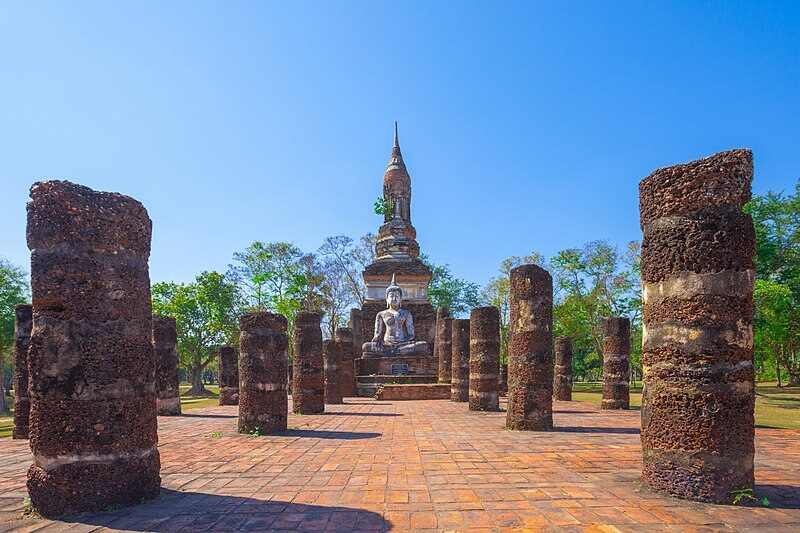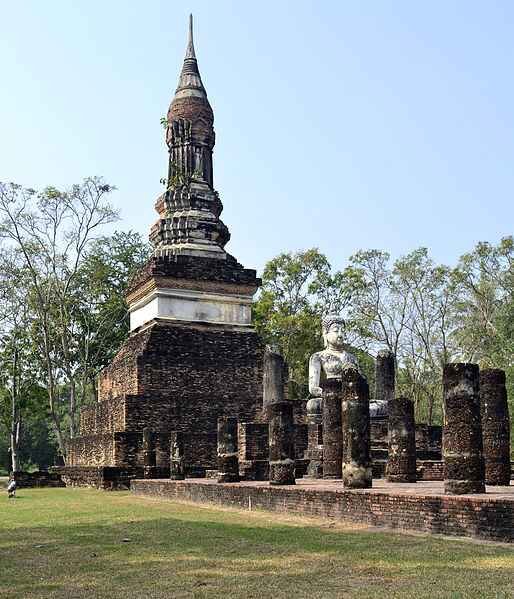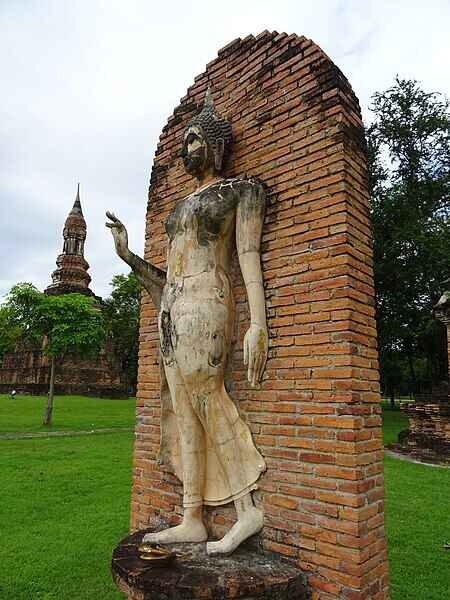Imagine stepping into a realm where history whispers through ancient ruins and the serene beauty of nature envelops you in tranquility.
Wat Traphang Ngoen, nestled within the enchanting Sukhothai Historical Park, is a testament to Thailand’s rich cultural tapestry.
This hidden gem, often overshadowed by its more famous counterparts, offers a unique blend of historical significance, architectural splendor, and spiritual serenity.
As you wander through its sacred grounds, you’ll find yourself transported back to the golden age of the Sukhothai kingdom, where every stone and statue tells a story of a bygone era.
Join us on a journey to uncover the secrets and splendors of Wat Traphang Ngoen, a place where the past and present harmoniously coexist.

Wat Traphang Ngoen in the Sukhothai Historical Park
Wat Traphang Ngoen is located within the Sukhothai Historical Park, a UNESCO World Heritage Site that showcases the ruins and remnants of the ancient Sukhothai kingdom.
The temple complex is a testament to the architectural and artistic achievements of the Sukhothai era, with its elegant stupas and Buddha images.
Visitors to Wat Traphang Ngoen can explore the temple grounds, marvel at the intricate carvings and sculptures, and learn about the fascinating history and legends associated with this sacred site.
The pond itself remains a source of wonder and inspiration, a reminder of the enduring power of faith and the resilience of the human spirit.
Wat Trapang Ngoen: History
Wat Traphang Ngoen, also known as the “Silver Lake Temple,” is a significant historical site within the Sukhothai Historical Park.
This temple dates back to the 14th century, during the reign of the Sukhothai Kingdom, which is often considered the golden age of Thai civilization.
The temple’s name is derived from its location beside a tranquil lake, which adds to its serene ambiance.
The origins of Wat Trapang Ngoen are somewhat mysterious, with no definitive records pinpointing its exact founding date.
However, it is believed to have been constructed during the reign of King Ramkhamhaeng the Great, the illustrious founder of the Sukhothai Kingdom.
The Legend Surrounding Wat Traphang Ngoen
Local folklore enriches the history of Wat Trapang Ngoen with intriguing legends.
One popular legend tells of a wealthy merchant named Phraya Jun, who, after losing all his possessions in a shipwreck, turned to Buddhism for solace.
Guided by a divine dream, he discovered a hidden treasure beneath a golden pond (trapang ngoen in Thai). Using this treasure, he built the temple as an act of gratitude.
Another legend speaks of the revered monk, Phra Maha Dharmaracha, who is believed to have resided and taught at the temple. His presence further enhanced the temple’s spiritual significance and drew many devotees and pilgrims.
According to Another folklore, during a time of drought and suffering in Sukhothai, a revered monk had a vision instructing him to dig at a specific spot within the city.
Following this divine guidance led to the discovery of a hidden spring that filled the pond now known as Traphang Ngoen.
This miraculous water was believed to possess healing properties, attracting pilgrims seeking relief from ailments. The pond thus became a sacred site where people would come to pray and bathe in hopes of receiving blessings and cures.

Significance
Wat Trapang Ngoen was a critical factor in shaping the religious and cultural aspects of the Sukhothai kingdom.
It served as a significant center for Buddhist teachings and ordinations, contributing to the spread of Theravada Buddhism throughout the kingdom.
The temple’s serene environment made it an ideal retreat for monks seeking enlightenment.
Architecturally, Wat Trapang Ngoen is a masterpiece of Sukhothai style.
The temple complex includes a large seated Buddha image facing the lake, a well-preserved chedi (stupa) with a lotus-bud shape symbolizing purity and enlightenment, and remnants of columns that add to its historical ambiance.
Architectural Marvels of Wat Traphang Ngoen
Wat Trapang Ngoen, a stunning example of Sukhothai architecture, showcases the artistic and architectural prowess of the Sukhothai kingdom.
Situated close to Wat Mahathat, this temple showcases a sizable standing Buddha statue and a lovely lotus pond, creating a peaceful area for contemplation.
Here are the key architectural features that make this temple a marvel.
1. The Principal Chedi
The centerpiece of Wat Traphang Ngoen is its principal chedi, which is emblematic of Sukhothai architecture.
Lotus Bud Design: The chedi is built on a five-tiered square base and topped with a lotus bud finial, symbolizing purity and enlightenment. This design is characteristic of Sukhothai architecture and represents a significant evolution from earlier Khmer styles.
Niches with Buddha Images: Just below the lotus bud are niches on each side of the chedi that originally housed standing and walking images of the Buddha. These niches not only enhance the aesthetic appeal but also serve a spiritual purpose, inviting worshippers to connect with the divine.
2. The Viharn (Assembly Hall)
In front of the main chedi lies the viharn, an assembly hall that serves as an important gathering space for worshippers.
Stuccoed Buddha Image: Inside the viharn, there is a large stucco image of the Buddha seated in the Bhumisparsha mudra, also known as “calling the Earth to witness.” This gesture signifies enlightenment and is one of the most revered postures in Buddhist iconography.
Architectural Remnants: While much of the viharn has deteriorated over time, its base and columns remain intact, showcasing traditional Sukhothai construction techniques. The design emphasizes open spaces that enhance communal worship experiences.
3. Smaller Chedi
Adjacent to the main chedi is a smaller chedi that adds to the temple’s architectural complexity.
Recalling Ayutthaya Influence: This smaller structure features indented corners and receding storeys, reminiscent of later Ayutthaya styles. It indicates a transitional phase in Thai architecture where influences from different periods began to merge.
Niches: Similar to the main chedi, this smaller structure also has large niches on each side, although they currently remain empty. This feature reflects a common practice in temple design where niches were used for housing images or relics.
Walking Buddha image: A elegant statue of a walking Buddha in the traditional Sukhothai style is displayed on a pedestal in front of it. The photo shows the Vitarka mudra, which signifies teaching and debate.
4. The Ubosot (Ordination Hall)
The ubosot is located on an island at the center of Traphang Ngoen pond, accessible via a bridge.
Symbolic Location: The placement of the ubosot on an island symbolizes purity and isolation from worldly distractions, making it an ideal space for ordination ceremonies and significant religious events.
Architectural Features: Although much of it has succumbed to time, remnants suggest it was designed with elegant lines and proportions typical of Sukhothai architecture. The ubosot often features intricate stucco work and detailed carvings that narrate Buddhist teachings.
5. Scenic Integration with Nature
Wat Traphang Ngoen’s architectural layout harmonizes beautifully with its natural surroundings.
Reflective Pond: The temple’s name translates to “Silver Pond,” highlighting its picturesque setting. The reflective quality of the pond enhances the beauty of the temple structures, creating stunning visual effects during sunrise and sunset.
Landscaping: The integration of water features into temple design is significant in Thai architecture, symbolizing tranquility and purity. The serene environment encourages meditation and contemplation among visitors.
In Summary, Wat Traphang Ngoen stands as a testament to the architectural ingenuity and spiritual depth of Sukhothai’s historical legacy.
Its combination of elegant structures, symbolic designs, and harmonious integration with nature makes it a captivating temples.

Festivals and Rituals
Wat Trapang Ngoen comes alive during the annual Loy Krathong festival. This festival, celebrated in November, involves floating decorated baskets on the lake to pay homage to the water spirits.
The sight of thousands of illuminated krathongs on the lake, with the temple in the background, is a mesmerizing experience.
♣♣To learn more about Sukhothai and Sukhothai Historical Park, make sure to check out our amazing post.⇒ Tremendous Sukhothai, Thailand: A Rich Historic Hub
You May Also Like: ⇓
- Daring Wat Si Chum: The Surprising Temple of Sukhothai
- Fascinating Wat Saphan Hin: A Hilltop Haven in Sukhothai
- Remarkable Blue Temple of the Chiang Rai, Thailand
- Beautiful Wat Rong Khun: Thailand’s Famous White Temple
Conclusion
Wat Traphang Ngoen is more than just a temple; it is a living testament to the artistic brilliance and spiritual heritage of the Sukhothai kingdom.
Each architectural element, from the majestic chedi to the serene ubosot, tells a story of devotion, creativity, and cultural significance that has endured through the ages.
The harmonious integration of nature and architecture invites visitors to not only admire its beauty but also to reflect on the deeper meanings embedded within its walls.
As you stand by the tranquil waters of the Silver Pond, surrounded by the echoes of history and the whispers of legends, you are reminded of the enduring power of faith and the timeless quest for enlightenment.
Wat Traphang Ngoen serves as a bridge connecting the past with the present, inviting all who visit to immerse themselves in its rich legacy.
Embrace the magic of Wat Traphang Ngoen and let its beauty inspire your journey through Thailand’s vibrant cultural tapestry.
1 thought on “Attractive Wat Traphang Ngoen: The Jewel of Sukhothai”